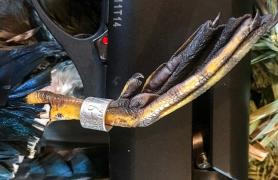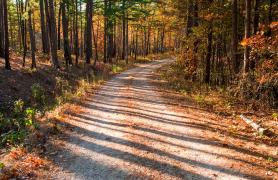The Atlanta Conservation Area (CA) in northeast Missouri is my favorite conservation area. My dad grew up in the town of Atlanta and, as a boy in the 1930s, he hunted the woods and Long Branch Creek bottomlands that would become the Atlanta CA in the 1960s.
Dad was thrilled when this large, diverse landscape became public. He enjoyed hunting it, even though he had plenty of access to local private lands. I still visit this area at least one or twice every year. It’s a long drive from my home in Lee’s Summit, but it’s always worth it.
Reconnecting With the Area
On a recent visit, my truck bounced to a stop in its familiar parking lot next to the maintenance area. I released Kevin, my German shorthair, slid the old shotgun from its case, and donned my hunting coat. Kevin and I headed due north and passed a pond that is being rehabilitated. I made a mental note to check it when it reopens because I am certain that the bass fishing will be good when it does. Kevin raced ahead and began a quartering search for quail. It’s very weedy here, and there is always lots of cover.
We passed a hardwood forest and entered a sunflower field that was established for dove hunting. Opening-day bird numbers were pretty good this year, but my shooting wasn’t. Still, it was fun, and we gave the area plenty of use that day. We skirted the edge of the sunflower field, now drab and lifeless, and continued on our way. We soon came to an area of small brushy draws and rolling hillsides.
I stopped at a familiar spot and looked over one hillside in particular. Kevin ran ahead, hitting the likely spots, and my mind rolled back the years.
Ten, 20, 30 — 50 years went by.
A Priceless Memory
The date is Nov. 11, 1967. I am standing in this exact spot and carrying the same shotgun. It is a warm, sunny Saturday and the second day of the Missouri quail season. A big hammer-headed, rawboned, liver-and-white pointer, appropriately named Rebel, races along the hillside in front of me. As he cuts from right to left, he suddenly slams into a point with his head cocked back to the right and his tail perfectly erect. My dad says, “All right, it’s your shot, go ahead.” I am 13 years old, and this is the season I carry my own new shotgun.
Dad has promised me first chance at a quail. Words cannot describe the excitement I feel. I don’t know how Mom and Dad afforded the new shotgun, but they did, and this is my chance.
Nervously, I walk in ahead of the dog, and a covey of perhaps 20 birds erupts. I raise the shotgun and fire — and it’s a clean miss. Then I remember Dad’s advice. “Focus on a single bird and try to tell if it’s a hen or a rooster. If you can tell that, you are focused enough.”
Fortunately for me, a couple of stragglers rise from the hillside weed patch and head toward the timber to the east. I concentrate hard on one bird, and I can tell it is a rooster. I swing the gun and shoot again. The sky explodes in feathers, and my first bobwhite quail tumbles to the ground. Rebel is on it instantly and makes a perfect retrieve to Dad. At that moment I wouldn’t trade that quail, that dog, or that shotgun for a million dollars. Today, I wouldn’t trade this memory for a million dollars.
Things Change, but There’s Still Plenty to Enjoy
Back in the 1960s and 1970s, there were more quail everywhere, and this area is no exception. During my last visit, I watched Kevin hunt the hillside hard, but the birds stayed out of sight. Still, I saw plenty of evidence that MDC is managing the area for quail — brush control, edge-feathering, and food plots with milo and foxtail. In time, the numbers will be better. A lot depends upon weather and luck.
We continued north and found another dove field. I picked up some empty shot shell cases to throw in the parking lot trash can, and I wished that everyone would pick up their own empties. I got some consolation, though — the high number of shell cases proved that someone is as poor a dove shot as I am. We continued on to a row-crop field and hit the edges. No luck there either, although the habitat looked great, and I was certain that the birds were there. It was likely that they were tucked away under some out-of-the-way place in heavy cover, and there was just too much for one dog to work all of it.
I bid Kevin toward the west, and we went nearly to the main area road before turning south and heading back toward the truck. We again hit the edges and found a couple of rabbits and more squirrels. Truly, this area is a paradise for a squirrel hunter — both fox and gray squirrels abound.
Memories Make it Personal
Kevin and I loaded up and headed to another spot where the quail hunting is better but without the special memories of this one. Atlanta CA is the place where I brought my then new bride 35 years ago when she wanted to know what quail hunting was like. She still goes with me sometimes on warm fall days.
It was also the place I came the day after my father’s funeral to wander the hillsides and try to make sense of it all. My father loved the concept of public lands managed for wildlife. He witnessed the demise of the prairie-chicken population on the prairies east of Atlanta where he worked on farms, and he recognized that, if we could leave just a little for the wildlife, it would be there for generations to come.
He understood how fragile wildlife populations could be. I think the idea
that there would be wildlife on conservation areas long after his passing gave him some measure of comfort, and it does for me as well.
2018 will mark 51 years of my chasing the quail on those hillsides. I hope November 11 is a warm, sunny day. I also hope you have a favorite area that you visit regularly, too. If not, why not find one? Missouri has nearly 1,000 conservation areas, and all of them can be special to someone.
Find Your Own Favorite Haunt
The 4,809-acre Atlanta CA in Macon County features hardwood forests, grasslands, wetlands, and several natural oxbow lakes. It is a great place to hunt, fish, watch birds, and enjoy outdoor Missouri in solitude — or with family and friends.
Missouri’s conservation areas vary in size from small stream accesses to multi-thousand-acre wildlife management areas. Some have been around a long time, and many were created after the Design for Conservation sales tax was enacted by popular vote in 1976. Whether small or large, old or new, all are unique, and all can become a favorite haunt. Browse MDC’s collection of nearly 1,000 conservation areas and find one to make your personal favorite at mdc.mo.gov/atlas.










Also In This Issue


And More...
This Issue's Staff
Associate Editor - Bonnie Chasteen
Staff Writer - Larry Archer
Staff Writer - Heather Feeler
Staff Writer - Kristie Hilgedick
Staff Writer - Joe Jerek
Creative Director - Stephanie Thurber
Art Director - Cliff White
Designer - Les Fortenberry
Designer - Marci Porter
Photographer - Noppadol Paothong
Photographer - David Stonner
Circulation - Laura Scheuler






















